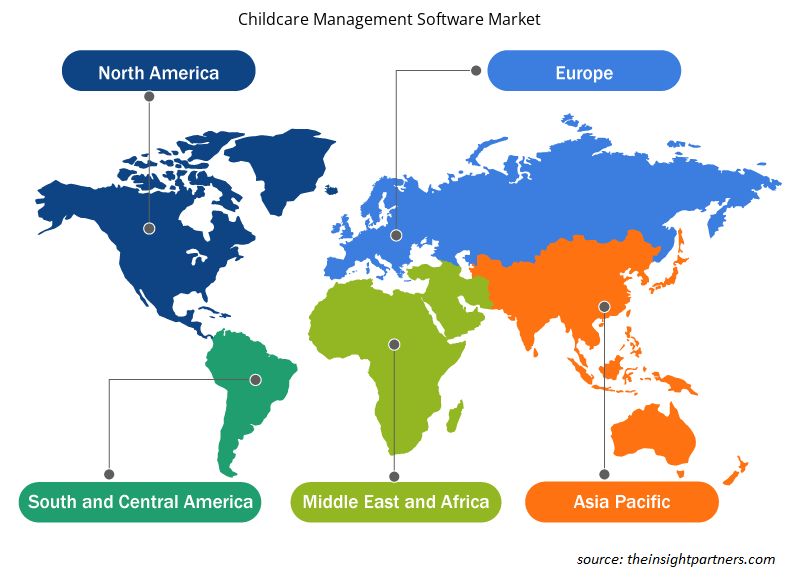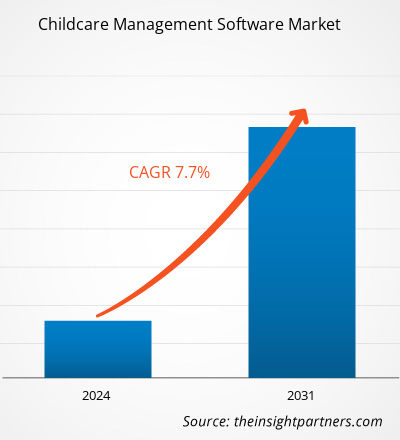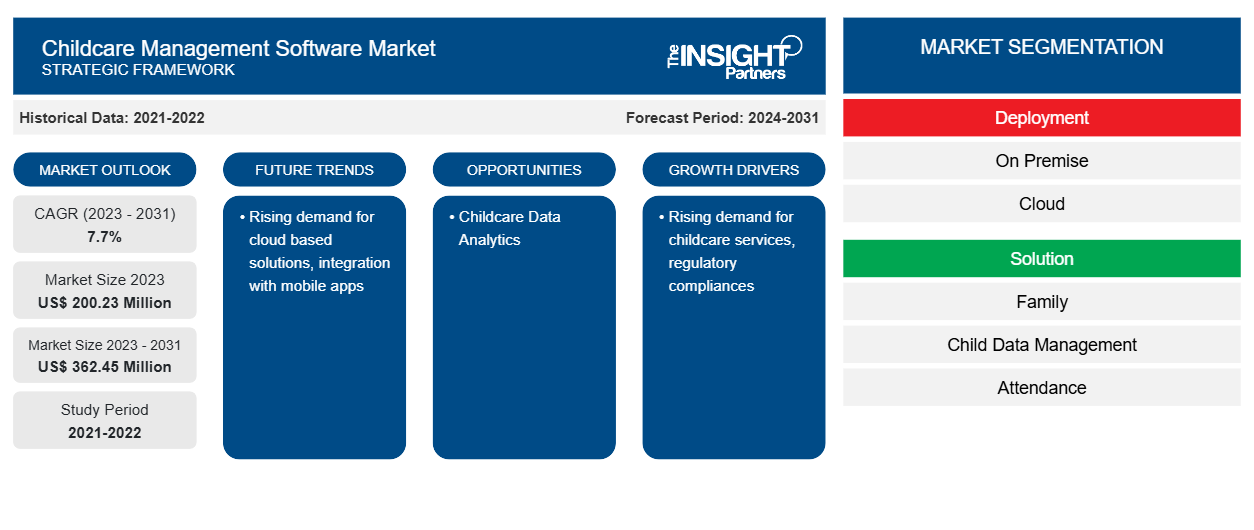Se prevé que el tamaño del mercado de software de gestión de guarderías alcance los 362,45 millones de dólares en 2031, frente a los 200,23 millones de dólares en 2023. Se espera que el mercado registre una CAGR del 7,7 % entre 2023 y 2031. Es probable que la creciente demanda de soluciones basadas en la nube y la integración con aplicaciones móviles sigan siendo tendencias clave del mercado de software de gestión de guarderías.
Análisis del mercado de software de gestión de guarderías
El software de gestión de guarderías es un tipo de software que se utiliza para ayudar a las guarderías y a las organizaciones de cuidado infantil a gestionar sus operaciones. Después de abrir un centro preescolar, se puede utilizar para diversos fines, como el seguimiento de la asistencia, la gestión del dinero y la comunicación con los padres. Un negocio de cuidado infantil eficiente y exitoso requiere una organización fluida, una comunicación eficaz y procedimientos administrativos simplificados, lo que impulsa la demanda del mercado de software de gestión de guarderías.
Descripción general del mercado de software de gestión de guarderías
La demanda mundial de software de gestión de guarderías está impulsada principalmente por el creciente número de padres en la fuerza laboral mundial. Esto genera la necesidad de cada vez más instituciones de cuidado infantil en todo el mundo, principalmente en las ciudades metropolitanas. Además, la necesidad de seguimiento en tiempo real de las actividades de los niños en estos centros de cuidado infantil está dando como resultado la adopción de un software de gestión de guarderías eficiente por parte de estos centros.
Personalice este informe según sus necesidades
Obtendrá personalización en cualquier informe, sin cargo, incluidas partes de este informe o análisis a nivel de país, paquete de datos de Excel, así como también grandes ofertas y descuentos para empresas emergentes y universidades.
-
Obtenga las principales tendencias clave del mercado de este informe.Esta muestra GRATUITA incluirá análisis de datos, desde tendencias del mercado hasta estimaciones y pronósticos.
Factores impulsores y oportunidades del mercado del software de gestión de guarderías
Cumplimiento normativo para favorecer el mercado
El cumplimiento normativo es un componente fundamental para el éxito de una guardería. Garantiza que los niños a su cargo estén seguros, sanos y felices, y que sus empleados estén debidamente capacitados, sean competentes y profesionales. El cumplimiento normativo también protege a su empresa de ramificaciones legales, sanciones financieras y daños a la reputación. Sin embargo, el cumplimiento normativo puede ser difícil de gestionar, especialmente en la dinámica y diversa industria del cuidado infantil. Existen numerosas regulaciones, estándares y mejores prácticas que debe seguir, que pueden diferir según su ubicación, tipo de servicio y estado de acreditación. Además, el cumplimiento normativo es un proceso continuo que requiere un seguimiento, actualización e informes periódicos. Los proveedores de cuidado infantil deben conservar numerosos registros de sus empleados, niños y familias, incluidos la asistencia, la salud, la inmunización, la inscripción, el contacto de emergencia y la información de pago. Estos registros deben actualizarse periódicamente y almacenarse de forma segura para garantizar la privacidad y confidencialidad de los datos. Sin embargo, el mantenimiento manual de estos registros puede llevar mucho tiempo, ser propenso a errores y ser un desperdicio. Esto impulsa la demanda de software de gestión de cuidado infantil en el mercado.reputational harm. However, compliance can be difficult to navigate, particularly in the dynamic and diverse childcare industry. There are numerous regulations, standards, and best practices that you must follow, which may differ depending on your location, service type, and accreditation status. Furthermore, compliance is a continuous process that necessitates regular monitoring, updating, and reporting. Childcare providers must preserve numerous records for their employees, children, and families, including attendance, health, immunization, enrollment, emergency contact, and payment information. These records must be updated on a regular basis and securely stored to ensure data privacy and confidentiality. However, manually maintaining these records can be time-consuming, error-prone, and wasteful. This drives the demand for childcare management software in the market.
Análisis de datos de guarderías: una oportunidad en el software de gestión de guarderías
Los servicios de cuidado infantil tienen un impacto significativo en el desarrollo de nuestra sociedad. Estos servicios, que abarcan desde la educación en la primera infancia hasta la protección de la seguridad y el bienestar de los niños, son fundamentales para el desarrollo integral de los padres que trabajan y de las mentes jóvenes. Sin embargo, gestionar centros de cuidado infantil de manera eficiente no es una tarea fácil. Los proveedores se enfrentan a diversos obstáculos, como mantener una atención de alta calidad, optimizar la asignación de recursos y garantizar el cumplimiento normativo. Aquí es donde el análisis de datos entra en juego como una herramienta valiosa para descubrir información e impulsar cambios positivos. El análisis ayuda a determinar el éxito de las iniciativas educativas y revela oportunidades de mejora, como mantener una buena limpieza, evitar accidentes y responder rápidamente a los problemas de salud.
Informe de mercado de software de gestión de guarderías Análisis de segmentación
Los segmentos clave que contribuyeron a la derivación del análisis del mercado del software de gestión de cuidado infantil son la implementación, la solución y la aplicación.
- Según la implementación, el mercado de software de gestión de guarderías se divide en local y en la nube. El segmento de la nube tuvo la mayor participación del mercado en 2023.
- Según la solución, el mercado de software de gestión de cuidado infantil se divide en gestión de datos familiares y infantiles, asistencia, contabilidad, gestión de tiempo y actividades, gestión de nutrición y otros.
- Según la aplicación, el mercado de software de gestión de cuidado infantil se divide en guarderías, cuidado antes y después del cuidado, preescolar, campamentos y otros.
Análisis de la cuota de mercado del software de gestión de guarderías por geografía
El alcance geográfico del informe de mercado de software de gestión de cuidado infantil se divide principalmente en cinco regiones: América del Norte, Asia Pacífico, Europa, Medio Oriente y África, y América del Sur / América del Sur y Central.
América del Norte ha dominado elMercado de software de gestión de guarderías. Los avances tecnológicos y las iniciativas adoptadas por los gobiernos de toda América del Norte están impulsando el crecimiento del mercado. El mercado de software de gestión de guarderías está experimentando un desarrollo sustancial en América del Norte, al que se puede atribuir un aumento significativo del empleo femenino en la región.
Perspectivas regionales del mercado de software de gestión de guarderías
Los analistas de Insight Partners explicaron en detalle las tendencias y los factores regionales que influyen en el mercado de software de gestión de guarderías durante el período de pronóstico. Esta sección también analiza los segmentos y la geografía del mercado de software de gestión de guarderías en América del Norte, Europa, Asia Pacífico, Oriente Medio y África, y América del Sur y Central.

- Obtenga datos regionales específicos para el mercado de software de gestión de guarderías
Alcance del informe de mercado de software de gestión de guarderías
| Atributo del informe | Detalles |
|---|---|
| Tamaño del mercado en 2023 | US$ 200,23 millones |
| Tamaño del mercado en 2031 | US$ 362,45 millones |
| CAGR global (2023 - 2031) | 7,7% |
| Datos históricos | 2021-2022 |
| Período de pronóstico | 2024-2031 |
| Segmentos cubiertos |
Por implementación
|
| Regiones y países cubiertos |
América del norte
|
| Líderes del mercado y perfiles de empresas clave |
|
Densidad de actores del mercado de software de gestión de guarderías: comprensión de su impacto en la dinámica empresarial
El mercado de software de gestión de guarderías está creciendo rápidamente, impulsado por la creciente demanda de los usuarios finales debido a factores como la evolución de las preferencias de los consumidores, los avances tecnológicos y una mayor conciencia de los beneficios del producto. A medida que aumenta la demanda, las empresas amplían sus ofertas, innovan para satisfacer las necesidades de los consumidores y aprovechan las tendencias emergentes, lo que impulsa aún más el crecimiento del mercado.
La densidad de actores del mercado se refiere a la distribución de las empresas o firmas que operan dentro de un mercado o industria en particular. Indica cuántos competidores (actores del mercado) están presentes en un espacio de mercado determinado en relación con su tamaño o valor total de mercado.
Las principales empresas que operan en el mercado de software de gestión de cuidado infantil son:
- Bloomz, Inc
- Eleyo
- Himama
- iclasspro
- Control de niños
- Centro de niños
Descargo de responsabilidad : Las empresas enumeradas anteriormente no están clasificadas en ningún orden particular.

- Obtenga una descripción general de los principales actores clave del mercado de software de gestión de guarderías
Noticias y desarrollos recientes del mercado de software de gestión de guarderías
El mercado de software de gestión de guarderías se evalúa mediante la recopilación de datos cualitativos y cuantitativos posteriores a la investigación primaria y secundaria, que incluye publicaciones corporativas importantes, datos de asociaciones y bases de datos. A continuación, se incluye una lista de los avances en el mercado de software de gestión de guarderías y las estrategias:
- Brightwheel, la plataforma líder de educación temprana integral, anunció la adquisición de Experience Early Learning, una marca reconocida a nivel nacional que desarrolla un sistema integral de evaluación y currículo de educación temprana basado en investigaciones. La adquisición de Bright Wheel reúne por primera vez lo mejor de las herramientas de aprendizaje físicas y digitales, lo que impulsa su objetivo de brindar educación temprana de alta calidad a todos los niños. (Fuente: Brightwheel, comunicado de prensa, 2023)
Informe de mercado sobre software de gestión de guarderías: cobertura y resultados
El informe “Tamaño y pronóstico del mercado de software de gestión de guarderías (2023-2031)” proporciona un análisis detallado del mercado que cubre las siguientes áreas:
- Tamaño del mercado y pronóstico a nivel global, regional y nacional para todos los segmentos clave del mercado cubiertos bajo el alcance
- Dinámica del mercado, como impulsores, restricciones y oportunidades clave
- Principales tendencias futuras
- Análisis detallado de las cinco fuerzas de Porter y PEST y FODA
- Análisis del mercado global y regional que cubre las tendencias clave del mercado, los principales actores, las regulaciones y los desarrollos recientes del mercado.
- Análisis del panorama de la industria y de la competencia que abarca la concentración del mercado, el análisis de mapas de calor, los actores destacados y los desarrollos recientes
- Perfiles detallados de empresas
- Análisis histórico (2 años), año base, pronóstico (7 años) con CAGR
- Análisis PEST y FODA
- Tamaño del mercado, valor/volumen: global, regional y nacional
- Industria y panorama competitivo
- Conjunto de datos de Excel
Informes recientes
Informes relacionados
Testimonios
Razón para comprar
- Toma de decisiones informada
- Comprensión de la dinámica del mercado
- Análisis competitivo
- Información sobre clientes
- Pronósticos del mercado
- Mitigación de riesgos
- Planificación estratégica
- Justificación de la inversión
- Identificación de mercados emergentes
- Mejora de las estrategias de marketing
- Impulso de la eficiencia operativa
- Alineación con las tendencias regulatorias























 Obtenga una muestra gratuita para - Mercado de software de gestión de guarderías
Obtenga una muestra gratuita para - Mercado de software de gestión de guarderías